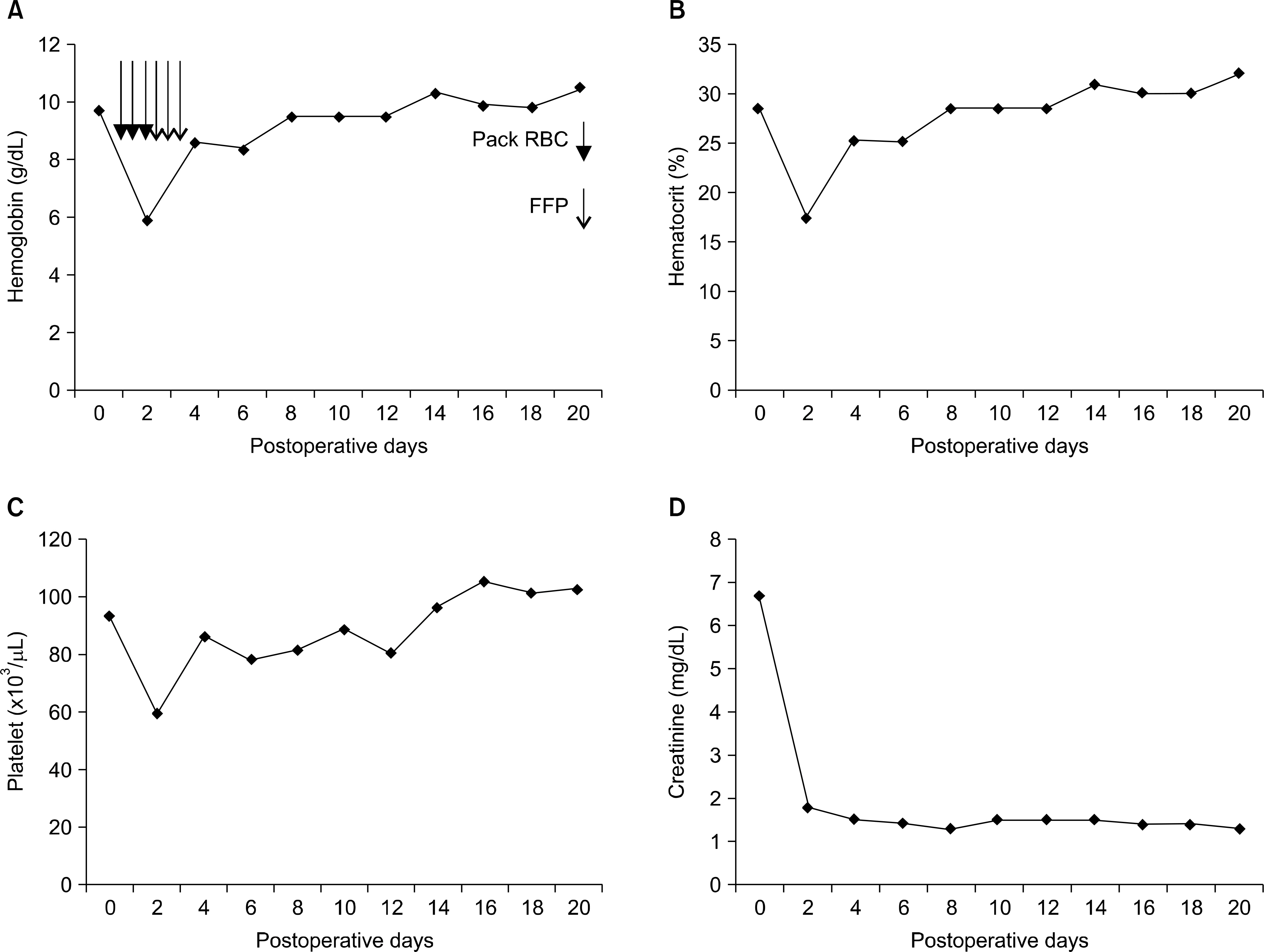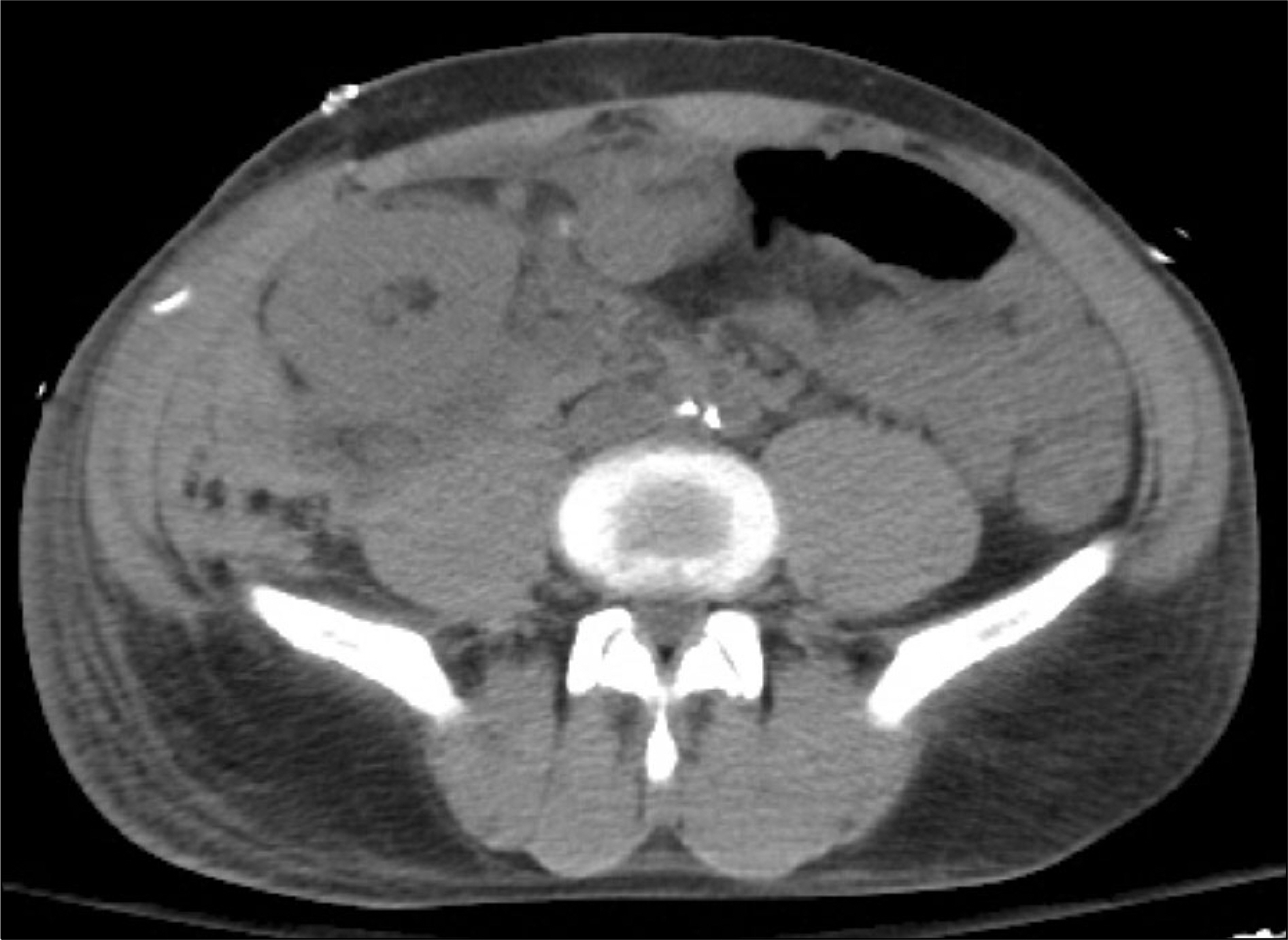J Korean Soc Transplant.
2015 Mar;29(1):28-32. 10.4285/jkstn.2015.29.1.28.
Living-donor Sequential ABO-incompatible Kidney Transplantation after Liver Transplantation in a Patient with Alcoholic Liver Cirrhosis and End-stage Renal Disease
- Affiliations
-
- 1Department of Surgery, Gangneung Asan Hospital, University of Ulsan College of Medicine, Gangneung, Korea. jhj@gnah.co.kr
- 2Department of Pathology, Gangneung Asan Hospital, University of Ulsan College of Medicine, Gangneung, Korea.
- 3Department of Anesthesia, Gangneung Asan Hospital, University of Ulsan College of Medicine, Gangneung, Korea.
- 4Department of Surgery, Asan Medical Center, University of Ulsan College of Medicine, Seoul, Korea.
- KMID: 2202561
- DOI: http://doi.org/10.4285/jkstn.2015.29.1.28
Abstract
- A 47-year-old man developed chronic alcoholic liver cirrhosis and end-stage renal disease. He underwent blood-type-compatible liver transplantation with a graft from his daughter. After 8 months, sequential ABO-incompatible (ABOi) kidney transplantation was performed, with his brother as the donor (A to O). The patient had anti-A antibody titers (1:256). We performed pretransplant desensitization, including administration of rituximab, mycophenolate mofetil, tacrolimus, and prednisolone 2 weeks before the scheduled transplantation, and plasmaphresis (PP) and administered an intravenous immunoglobulin injection. The patient underwent PP before kidney transplantation until the anti-A antibody titer was <1:8. The patient achieved normal renal function within 4 posttransplantation days. Postoperative bleeding (diffuse hemorrhage) requiring additional blood transfusions and radiological intervention (drainage procedure) occurred 9 days after transplantation. The patient was discharged on day 20 of hospitalization. Nine months after the kidney transplantation, the recipient's and donor's liver and kidney functions were normal. ABOi renal transplantation after liver transplantation can be successfully performed in patients with high baseline anti-ABO antibody titers after preconditioning with rituximab and PP, and quadruple immunosuppressive therapy. However, caution is required regarding an increased risk of bleeding complications.
Keyword
MeSH Terms
Figure
Reference
-
References
1). Bertelli R, Nardo B, Cavallari G, Ercolani G, Lauro A, Neri F, et al. Kidney transplantation combined with other organs in Bologna: an update. Transplant Proc. 2008; 40:1867–8.
Article2). Nakamura M, Fuchinoue S, Nakajima I, Kitajima K, Tojimbara T, Takasaki K, et al. Three cases of sequential liver-kidney transplantation from living-related donors. Nephrol Dial Transplant. 2001; 16:166–8.3). Rahman T, Harper L. Plasmapheresis in nephrology: an update. Curr Opin Nephrol Hypertens. 2006; 15:603–9.
Article4). Tobian AA, Shirey RS, Montgomery RA, Tisch DJ, Ness PM, King KE. Therapeutic plasma exchange reduces ABO titers to permit ABO-incompatible renal transplantation. Transfusion. 2009; 49:1248–54.
Article5). Shimmura H, Tanabe K, Ishida H, Tokumoto T, Ishikawa N, Miyamoto N, et al. Lack of correlation between results of ABO-incompatible living kidney transplantation and an-ti-ABO blood type antibody titers under our current immunosuppression. Transplantation. 2005; 80:985–8.
Article6). Sonnenday CJ, Warren DS, Cooper M, Samaniego M, Haas M, King KE, et al. Plasmapheresis, CMV hyperimmune globulin, and anti-CD20 allow ABO-incompatible renal transplantation without splenectomy. Am J Transplant. 2004; 4:1315–22.
Article7). Mor E, Nesher E, Ben-Ari Z, Weissman I, Shaharabani E, Eizner S, et al. Sequential liver and kidney transplantation from a single living donor in two young adults with primary hyperoxaluria type 1. Liver Transpl. 2013; 19:646–8.
Article8). Kim MH, Jun KW, Hwang JK, Kim JI, Chung BH, Choi BS, et al. Risk Factors for Postoperative Bleeding in ABO-Incompatible Kidney Transplantation. Clin Transplant. Epub 2015 Feb 3. DOI:. http://dx.doi.org/10.1111/ctr.12525.9). Gelabert A, Puig L, Maragall S. Coagulation alterations during massive plasmapheresis. Sieberth HG, editor. ed,. Plasma exchange. Stuttgart: Schattauer Verlag;1980. : 71.
- Full Text Links
- Actions
-
Cited
- CITED
-
- Close
- Share
- Similar articles
-
- Overcoming high pre-transplant isoagglutinin titers using high-dose intravenous immunoglobulin, salvage plasmapheresis, and booster rituximab without splenectomy in ABO-incompatible living donor liver transplantation: a case report
- ABO-Incompatible Kidney Transplantation
- ABO-incompatible living donor liver transplantation with a simplified desensitization and immunosuppression protocol: a single center retrospective study
- ABO-Incompatible Living Donor Liver Transplantation
- Successful Pediatric ABO-Incompatible Kidney Transplantation without Pretransplant Plasmapheresis: Report of a Case




